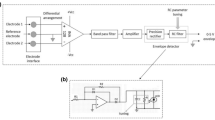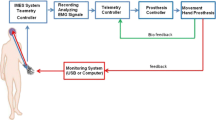Abstract
In the process of improvement of prosthetic devices, there have been efforts to develop satisfactorily working artificial hands but still lots of work is to be done to meet the accuracy and requirements of the human hand movement. The EMG signal has been most promising signal in development of artificial limbs. The present review paper gives the historical developments in three main sections. First part describes the EMG signal properties. Second part deals with the mathematical models developed till now for EMG signal analysis. In the third part different design approaches have been reviewed for artificial hand. First approach discussed here is on the body-powered terminal devices which are controlled by the user’s pull on the control cable to open the hand or hook and for the grip strength. Other being myoelectric controls type, an externally-powered system which uses electrical impulses, generated by contraction of the amputees own remaining muscles to operate a motor in a mechanical hand, hook or elbow. This paper presents a brief overview of above mentioned issues with regard to artificial hands.








Similar content being viewed by others
References
P. Kyberd, The intelligent hand. IEE Rev. 46(5), 31–35 (2000)
S. Schulz, C. Pylatiuk, G. Bretthauer, A new ultralight anthropomorphic hand, in Proceedings of IEEE International Conference on Robotics and Automation, ICRA 2001, vol. 3 pp. 2437–2441
T. Farnsworth, The call to arms. BSME, CP, FAAOP, Active Living Magazine, 3 Aug 2004
M.B.I. Reaz, M.S. Hussain, F. Mohd-Yasin, Techniques of EMG signal analysis: detection, processing, classification and applications. Biol. Proc. Online 8(1), 11–35 (2006). doi:10.1251/bpo115
F. Mobasser, J.M. Eklund, K. Hashtrudi-Zaad, Estimation of elbow-induced wrist force with EMG signals using fast orthogonal search. IEEE Trans. Biomed. Eng. 54(4), 683–693 (2007)
S.K. Kundu, K. Kiguchi, EMG controlled robotic elbow prosthesis as an inner skeleton power assist system, in Proceedings of the 4th IEEE International Conference on Mechatronics, ICM2007, 8–10 May 2007, pp. 1–6
A.S. Arora, Modified adaptive resonance theory based control strategy for EMG operated prosthesis for below-elbow amputee. J. Med. Eng. Technol. 31(3), 191–201 (2007)
K. Kiguchi, T. Tanaka, T, Fukuda, Neuro-Fuzzy Control of a Robotic Exoskeleton with EMG Signals. IEEE T. Fuzzy Syst. 12(4), 481–490 (2003)
H.-P. Huang, C.N. Chen, Development of a myoelectric discrimination system for a multi-degree prosthetic hand, in Proceedings of the 1999 IEEE International Conference on Robotics & Automation Detroit, Michigan, May 1999, p. 2392
C.J. De Luca, Physiology and mathematics of myoelectric signals. IEEE Trans. Biomed. Eng. BME-26(6), 313–325 (1979). doi:10.1109/TBME.1979.326534
D. Graupe, Functional separation of EMG signals via ARMA identification. IEEE Trans. Syst. Man Cybern. SMC-5, 252–259 (1975)
G.C. Agarwal, G.L. Gottlieb, An analysis of the electromyogram by fourier, simulation and experimental techniques. IEEE Trans. Biomed. Eng. BME-22(3), 225–229 (1975)
E. Shwedyk, R. Balasubramanian, R.N. Scott, A nonstationary model for the electromyogram. IEEE Trans. Biomed. Eng. BME-24(5), 417–424 (1977)
J.N. Helal, J. Duchene, A pseudoperiodic model for myoelectric signal during dynamic exercise. IEEE Trans. Biomed. Eng. 36(11), 1092–1097 (1989)
R.R. Knox, D.H. Brooks, E. Manolakos, S. Markogiannakis, Time-series based features for EMG pattern recognition: preliminary results, in Proceedings of the 1993 IEEE Nineteenth Annual Northeast Bioengineering Conference, 18–19 March 1993, pp. 1–2
Y.T. Zhang, W. Herzog, M.M. Liu, A mathematical model of myoelectric signals obtained during locomotion, in Proceedings of the IEEE 17th Annual Conference on Engineering in Medicine and Biology Society, vol. 2, 20–23 Sept 1995, pp. 1403–1404
B. Anctil, M.P. Slawnych, An efficient method for modeling EMG potentials as recorded using surface electrodes, in Proceedings of the 20th Annual International Conference of the IEEE on Engineering in Medicine and Biology Society, vol. 5, 29 Oct–1 Nov 1998, pp. 2613–2615
R. Tomovic, G. Boni, An adaptive artificial hand. IRE Trans. Automat. Contr. AC-7(3), 3–10 (1962)
S. Wongsiri, S. Laksanacharoen, Design and construction of an artificial limb driven by artificial muscles for amputees, in Proceedings of the 2003 PSU-UNS International Conference on Energy and the Environment, Prince of Songkla University, Hat Yai, Songkla, Thailand, Dec 11–12, 2003
Y. Kuba, M. Wada, H. Endo, An interfacing method between an artificial hand and human, in Proceedings of the IEEE International Workshop on Robot and Human Communication, 1–3 Sept 1992, pp. 194–198
F. Pfeiffer, Grasping with hydraulic fingers—an example of mechatronics. IEEE/ASME Trans. Mechatron. 1(2), 158–167 (1996)
Y.K. Lee, I. Shimoyama, A skeletal framework artificial hand actuated by pneumatic artificial muscles, in Proceedings of the 1999 IEEE International Conference on Robotics & Automation, Detroit, Michigan, May 1999, p. 926
S. Beck, R. Mikut, A. Lehmann, G. Bretthauer, Model-based control and object contact detection for a fluidic actuated robotic hand, in Proceedings of the 42nd IEEE Conference on Decision and Control, Maui, Hawaii, USA, December 2003, p. 6369
D. Graupe, J. Magnussen, A. Beex, A microprocessor system for multifunctional control of upper-limb prostheses via myoelectric signal identification. IEEE Trans. Automat. Contr. 23(4), 538–544 (1978)
G.C. Ray, S.K. Guha, Relationship between the surface-EMG and muscular force. Med. Biol. Eng. Comput. (Great Britain) 21(5), 579 (1983)
M. Bergamasco, M.S. Scattareggia, The mechanical design of the MARCUS prosthetic hand. in Proceedings of the 4th IEEE International Workshop on Robot and Human Communication, RO-MAN'95 TOKYO, 5–7 July 1995, pp. 95–100
R. Okuno, M. Yoshida, K. Akazawa, Development of biomimetic prosthetic hand controlled by electromyogram, in Proceedings of the 4th International Workshop on Advanced Motion Control, vol. 1, 18–21 March 1996, pp. 103–108
C.P. Fermo, C.V. De Vincenzo, T.F. Bastos-Filho, V.I. Dynnikov, Development of an adaptive framework for the control of upper limb myoelectric prosthesis, 2000, in Proceedings of the 22nd Annual International Conference of the IEEE on Engineering in Medicine and Biology Society, vol. 4, 23–28 July 2000, pp. 2402–2405. doi:10.1109/IEMBS.2000.901282
S. Morita, T. Kondo, K. Ito, Estimation of forearm movement from EMG signal and application to prosthetic hand control. in Proceedings of the 2001 IEEE International Conference on Robotics & Automation, Seoul, Korea, 21–26 May 2001, p. 3692
Y. Saito, A. Ogawa, H. Negoto, K. Ohnishi, Development of intelligent prosthetic hand adapted to age and body shape, in Proceedings of the 2005 IEEE 9th International Conference on Rehabilitation Robotics, Chicago, IL, USA, 28 June–1 July 2005, p. 384
J. Zajdlik, The preliminary design and motion control of a five-fingered prosthetic hand. 10th international conference on intelligent engineering systems, INES 2006, p. 202
J. Finat, J. Lopez-Coronado, A hybrid model for the hand preconfiguration in rehabilitation grasping tasks, 1998, in Proceedings of the IEEE International Conference on Systems, Man, and Cybernetics, vol. 4, 11–14 Oct 1998, pp. 3448–3453. doi:10.1109/ICSMC.1998.726551
A.S. Arora, Development of control strategies for EMG based control of multifunction prosthetic hand. Ph.D. Thesis, Indian Institute of Technology, Roorkee, 2002
http://www.ottobockus.com/PRODUCTS/UPPER_LIMB_PROSTHETICS/myoelectric_hands.asp
Author information
Authors and Affiliations
Corresponding author
Rights and permissions
About this article
Cite this article
Ryait, H.S., Arora, A.S. & Agarwal, R. Study of issues in the development of surface EMG controlled human hand. J Mater Sci: Mater Med 20 (Suppl 1), 107–114 (2009). https://doi.org/10.1007/s10856-008-3492-4
Received:
Accepted:
Published:
Issue Date:
DOI: https://doi.org/10.1007/s10856-008-3492-4




